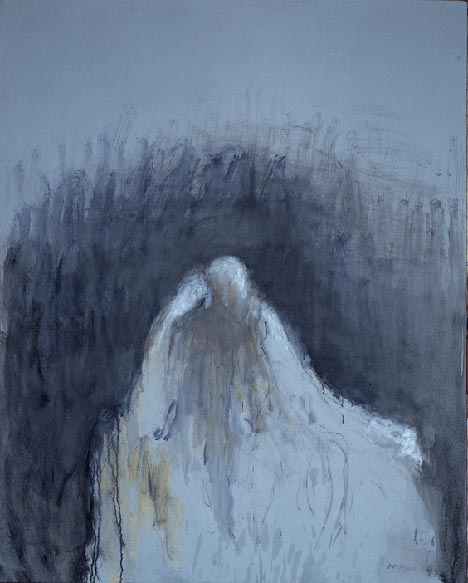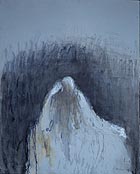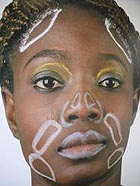
translated and summarized by: Liz Wollner-Grandville,
English summary March 25 - 31
Belvedere: Kokoschka – Träumender Knabe – Enfant Terrible
Shaved and talented
One can’t incessantly rant and rave. Not even about the Österreichische Galerie and its administration, which has been installed last year. I visited the Belvedere, the lower Belvedere. And I must admit that the exhibit on Kokoschka’s early works “Träumender Knabe – Enfant Terrible” (Dreaming lad – Enfant Terrible), is really well done. Kokoschka is a neat character. And so is the show.
People enjoy playing around with the word Expressionism when they talk about classic Modernism. The members of the artist group Der Blaue Reiter (The Blue Rider) were supposedly Expressionists, and so was Henri Matisse. But if someone should truly be considered an Expressionist, then it should be that boy from Pöchlarn, the one who shaved his head, that’s how talented he was.
It is self-explanatory that these kinds of presentations teem with confessions made in the first tense. But the media supporting the ego is new. And this media is not so much the body but its shrinkage. The bearer of these ecstasies is the flesh - the naked, exposed, unveiled, gaping flesh. And this is how it presents itself – with a wound in its side or without any epidermis at all. The Wiener Aktionismus (Vienna Actionism) in a kind of personal union.
In this atmosphere of realism no intention is able to subsist. However, if it does subsist, then the artist’s brain is confused. In this case the outcome of his confusion was the production of a substitute for Alma, in the form of a puppet. The puppet was redone for this exhibit and she really resembles Mrs. Mahler-Gropius-Werfel.
I repeat: well done. Nothing to rage about? Well, yes: only the curator Alfred Weidlinger wrote the catalogue. You can check that by carefully examining the imprint. But he did not write the entire catalogue by himself – the introduction was written by Mrs. Husslein. Two pages against 280. Puppet against potential. What is there left to be said.
Belvedere
1030 Wien, Prinz-Eugen-Strasse 27, until 12.05.08
www.belvedere.at
Fundació Caixa Catalunya: Zoran Music
Painting as a testimonial
Zoran Music, born 1909, grew up in Croatia and Austria during the Habsburg monarchy and spent the majority of his life in Venice, where he died in 2005. He studied art and in 1944, after a stay in Madrid, he was arrested under the accusation of collaborating with the partisans in Trieste and taken to the concentration camp Dachau. Here Music created some of his most dismal and gripping sketches depicting the horrors of the concentration camp; after 1945 he painted wonderfully poetic landscapes and vedute.
All of Music’s early works were strongly influenced by the horrors of Dachau. A pasty, nearly Impressionistic style as well as different shades of brown dominate his later oeuvre (as of the 60s). The motives are reduced to the basics, showing a schematic depiction of a person or just the silhouette of a building.
In his late work, the figures seem to dissolve and finally they are only sketches, nearly disappearing entirely into a minimal gesture.
Music’s late works, which he created in his last 15 years, are - somewhat surprisingly - his strongest. These powerful portraits and figures, which remind of Giacometti's drawings, are – although they come across like an empty space in the background - exceptionally captivating. Just like only the work of an artist remains after his death, Music’s figures only leave their unidentifiable stains on a coarsely cast colored plane.
Fundació Caixa Catalunya, Barcelona
La Pedrera Exhibtion Hall. Passeig de Gràcia, 92 until 18.05.08
www.undaciocaixacatalunya.org
Siemens_artLab: Christina Tsilidis – Idealgesicht
Beauty as a nightmare scenario
Christina Tsilidis' current exhibit at the Siemens_artLab deals with the absurd excesses of the ideals of beauty as the media propagates them.
At first the precisely photographed beautiful, bizarre painted faces mounted on the artLab walls seem to direct their eyes toward you with a blank stare. Soon it becomes clear that the “make-up” is a special marking made by cosmetic surgeons to outline the divergence from an abstract ideal of beauty. These marks show how they would transform the faces to seemingly ideal faces. The absurd consequences of a completely uninhibited beauty craze are presented without crossing the borders of ignobility, in contrast to Orlan’s work.
The fact that all of the depicted female faces are beautiful and young is extremely irritating. It is a nightmare scenario to think that they could all lose they individual beauty, each characterized by precious and beautiful differences, by being pruned according to the same standards.
Siemens_artLab
1010 Vienna, Dorotheergasse 12, until 03.04.08
www.artLab.at
Haus der Kulturen der Welt: Re-Imagining Asia. A Thousand Years of Separation
Heterotopias of the imaginary: Pan Asiatic identities
In her simultaneous projections the Korean artist Kimsooja stands in the middle of a crowd in Delhi, Tokyo, New York, or Shanghai like a petrified statue with her back facing the camera and displays alleged and real heterotopias of the self. In her videos the bizarre paralyzed self, which seems space- and timeless, observes its surroundings and simultaneously negates its location. Kimsooja’s lifeless displacement overcomes the connection to a culture or a nation by illustrating how the personal identity has detached itself from the collective identity.
Even artists who are not native Asians, such as the German Andreas Gursky or the Mexican Gabriel Orozco watch Asia closely. But this has more to do with a globalized art world than with any kind of a Pan Asiatic aspect. For many years artists like Rirkrit Tiravanija, living in Berlin, New York and Bangkok, have already worked beyond the “fundamentalism of a location”, which only seemingly offers an identity (with reference to Byung-Chul Han’s phenomenology of hyper culture). Re-Imagining Asia. A Thousand Years of Separation, staged jointly by the curators Wu Hung and Shaheen Merali attempts to reassess how Asia shapes itself as an imaginary space, separate from national or sexual identities; many artists refer to Asia in a philosophical and aesthetic manner.
Bharti Kher, who has returned to India from Great Britain, wants to interpret the plurality of history by covering the tanned skin of her life-size fiberglass elephant with glittering bindis. “The skin speaks a language of its own”: the elephant as a Pan Asiatic symbol of dignity, power and wisdom has prostrated before the effects of mass media, pop- and consumer culture. In an interview the artist unmasks the historical (formerly western) understanding of progress and modernism: “( …) in a country like India, there’s always this clearing away of the old and making of the new, in the sense that we don’t keep the cultural heritage (…) most of everything in India is disappearing quite quickly and I think that’s part of the culture.”
Haus der Kulturen der Welt
10557 Berlin, John-foster-Dulles-Alle 10, until 18.05.08
www.hkw.de
Galerie Martin Janda Raum aktueller Kunst: Joe Scanlan – Creative Destruction
Traveling Salesman Circular Economy
“Attractive” economy
Joe Scanlan, who has recently designed a modular lightweight pavilion for the large area beneath the glass cupola of the K21 in Düsseldorf, has a huge potential of creative political self-confidence. His work focuses on art, architecture, design and poetry in context with economy. In a grandiose exhibit, parts of the famous book written by the Austrian economist J. A. Schumpeter (1883 – 1950) “Capitalism, Socialism and Democracy”, first published in 1942, are mounted as a space-filling wall piece in the Galerie Martin Janda Raum aktueller Kunst.
With his all over artwork Scanlan strongly influences the way in which visitors perceive the gallery. He construes and interprets the different stages of Schumpeter’s text by dividing it into three different shades of blue. This not only elucidates the characteristics of economic life but also the development of art. Schumpeter’s groundbreaking hypothesis on the process of “creative destruction”, which assumes that in a functioning capitalistic economy old economic structures are destroyed to create new ones, is adopted by Scanlan in such a way, that he makes the necessity of permanent change just as evident as the distinction between the respective generations of producers. Regarding the current grave economic problems in the USA, this is a praiseworthy artistic message. First, it shows that capitalism never was, or is, the result of a peaceful market growth. Secondly, the close connection between the collapse of abstract (added) value and the quantitative conception of nature becomes evident. Thirdly, to attain maximum profit, industrial capitalism has disowned the factor of straightforward (manual) work involved in direct production.
In order to adapt to the necessities of a society and not vice versa, Scanlan, as a kind of traveling salesman, created uncomplicated functional art works for his exhibits - something every manufacturer in a truly democratic consumer-oriented society should aim at. Among these works is a portable folding table with publications by the artist, which are aimed at disseminating new ideas on mobility and art consumption. Scanlan pushes on with the dynamics of creative destruction by incessantly discovering new production-, display-, and distribution-niches for his art. He works like a craftsman who is so dedicated to his work that he won’t let anyone else get involved in the production process. Suddenly economics, opposed to the Theory of Marxism, receives a positive meaning, because Scanlan has enriched the term with existential intensity.
Galerie Martin Janda Raum aktueller Kunst
1010 Vienna, Eschenbachgasse 11, until 12.04.08
www.martinjanda.at
Mehr Texte von translated and summarized by: Liz Wollner-Grandville


 Teilen
Teilen




